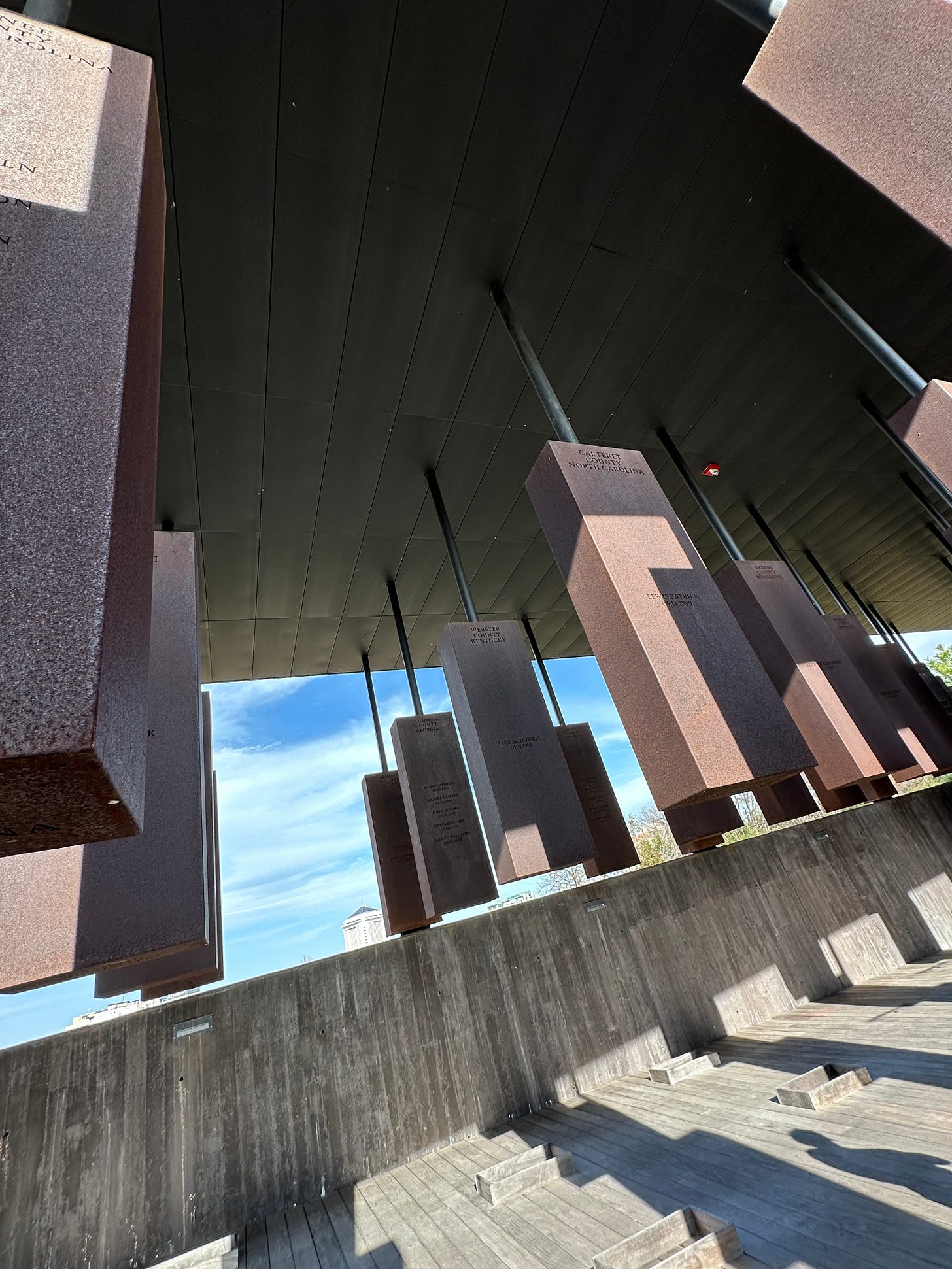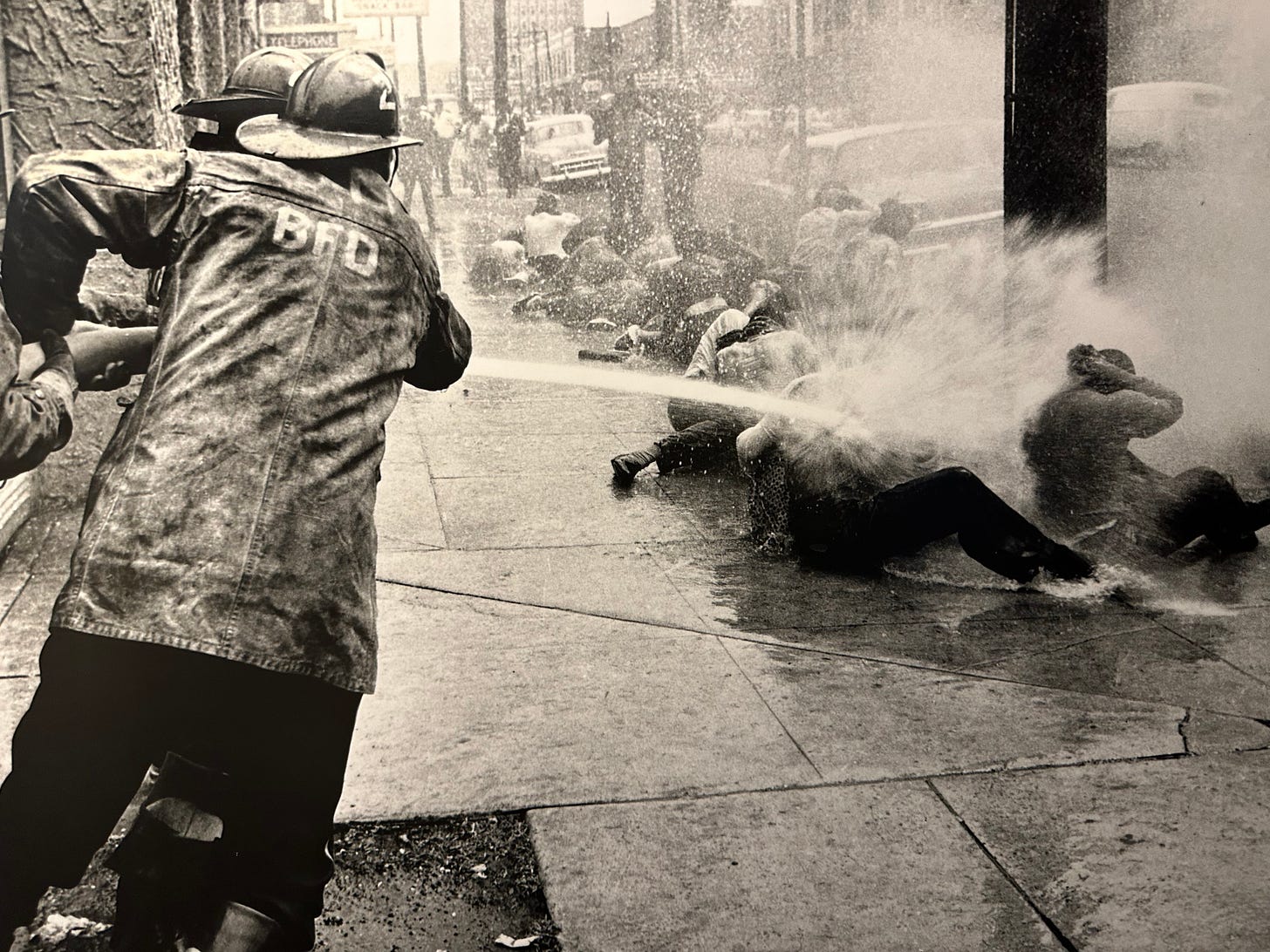Reflection in Alabama
Journal Entry #53
February 6, 2025
The past 2 weeks’ of wandering has taken us from Florida into Alabama, Mississippi and Louisiana. Given it is our third time van-ing it in the southeast (we typically head south then west in order to avoid poor weather and driving conditions) we thought we would spend time in places we hadn’t visited before.
Neither of us had spent much time at all in Alabama; it had generally been a state that we “passed through” on our way to somewhere else. Mostly, we had cruised through the southern tip of the state on route 10. So this time we decided to make our way to Montgomery.
Our first stop in the city was the Freedom Monument and Sculpture Garden, one of three Legacy sites established by the Equal Justice Initiative, led by attorney Bryan Stevenson.
We arrived on a quiet, overcast Monday morning, well before the school groups and had the meandering path to ourselves. The site consists of large scale art and narrative exhibits centered around the story of slavery in the US with a lens on the enslaved peoples’ experiences.
Along the path were markers that recounted personal narratives. As early as the 1500’s the Spanish were abducting and enslaving people from the African and South American continents as they explored the new world. Indigenous peoples were also enslaved and removed from their lands. We learned that In Alabama alone, the Creek people were forced to cede 23 million acres of their land in Alabama after their defeat in 1814 to Andrew Jackson. As the cotton industry boomed, Montgomery became the epicenter of the slave trade.
At a spot overlooking the Alabama River we read the narrative of a slave who was forcibly separated from his wife and children and whose three attempts to escape were were foiled; he was beaten and resold to new owners.
We read the laws enacted across most of the southern states detailing the physical punishments for the “misbehavior” of slaves including one caution that it was illegal to “cut the tongue or gouge the eyes” of a slave for minor offenses but death was an acceptable punishment for more serious offenses.
I think what struck us most was both the magnitude of the harm we did to so many in the name of progress and the sheer brutality of it, which was completely normalized in our society. The agricultural and industrial advances in the US were achieved on the backs of people stolen from their homes and families, shackled, transported; sold and traded like animals, and worked literally to death.
We learned later in our visit to the EJI Legacy Museum that even after international trade in humans was made illegal in 1808, the interstate trade in enslaved people boomed. Markets like Montgomery were buoyed by distribution channels that moved humans via steamboat and newly constructed railroads. The common phrase “you were sold down the river” comes from the experience of the enslaved.
When we reached the end of the path, we stood before a monumental wall with 122,000 surnames representing the 4.7 million formerly enslaved people that were recorded at the time of 1870 Census.
As an American Jew, the number “six million” was a number burned into my memory. it was a part of my family’s history and of our cultural identity. I was taught that six million Jews were killed in the concentration camps in Germany and that I should never forget those millions who suffered and died in the Holocaust. I learned that brutality like this arises when people permit, accept and encourage the dehumanization of others.
Standing before this wall, I reflected on the fact that we permitted and accepted the dehumanization and brutalization of so many millions of people here, not to speak of the fact that all of this occurred on stolen land.
We both consider ourselves well-read and aware of the dark chapters of our history. Even so, the monument and the museum served as a reminder that much of the history we were taught in school in the 1970’s and 80’s (me in Virginia and Tom in Tennessee) was whitewashed. Our lessons about this period of American history more often focused on the “outcome” —the signing of the Emancipation Proclamation— as a sort of heroic punctuation mark at the end of the civil war which “ended” slavery.
But, the fact is that for nearly 100 years after the Emancipation, wide spread lynchings and violent mob vigilantism served to terrorize and intimidate black American citizens, especially in the southern states. Jim Crow laws were enacted that reinforced racism and dehumanized and marginalized black Americans.
Our third stop in Montgomery was the National Monument for Peace and Justice. It serves to acknowledge the people who were the victims of these lynchings in the US. The memorial honors the lives of 4,400 black Americans who were murdered by lynch mobs in racially motivated killings from 1877 to 1950.
As we walked through the monument, the clouds cleared and sun came out. The bright blue skies contrasted with red-brown rows of large rusted steel monoliths, each of which was suspended from the ceiling of a square shaped memorial. The monoliths reminded us of large coffins suspended in air. They also echoed the silhouettes of those who were lynched and hung from trees in public squares. Listed on each of these giant metal boxes were the names of the people in each county - across 12 US states - who had been killed in lynchings.
We carried northward to Birmingham to visit the Birmingham Civil Rights institute. The institute focuses on the civil rights movement and the Birmingham campaign led by Dr. King and Reverend Fred Shuttlesworth; the non violent direct action movement that brought attention nationwide to the injustices of segregation. The movement eventually led to the signing Civil Rights Act of 1964 by President Johnson and the passage of the Voting Rights Act of 1965.
Again, while we both knew the history of this period in broader brush strokes, we were particularly struck by the stories of the violent reaction by white residents to the peaceful movement in the City of Birmingham itself. Town square lynchings may have ended but they were replaced by bombings (the city was nicknamed “Bombingham”), police brutality, firehoses and attack dogs as forms of terror.
Our days in Montgomery and Birmingham were heavy with reflection. Visiting these places felt especially relevant given the current and continued struggles for the rights of immigrants, LGBTQIA, and other marginalized groups and given the epidemic of mass incarceration in our country that disproportionately impacts people of color.
You ultimately judge the civility of a society not by how it treats the rich, the powerful, the protected and the highly esteemed, but by how it treats the poor, the disfavored and the disadvantaged.
—Bryan Stevenson
For additional information:
https://eji.org
https://lynchinginamerica.eji.org/
P.S. https://thehill.com/blogs/in-the-know/5135981-kendrick-lamar-super-bowl-halftime-performance-serena-williams-drake-not-like-us/










You went! Forget Disney, I believe that this is the most important pilgrimage that everyone doing tourism or travel in the US must make. Thank you for sharing ❤️
Thank you!